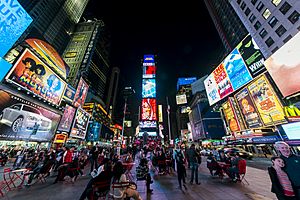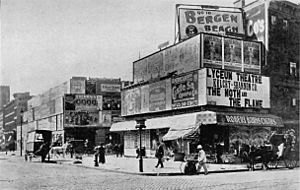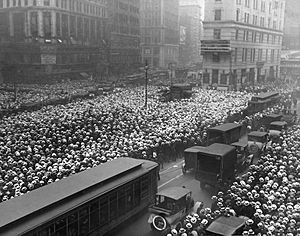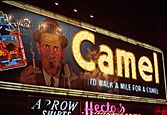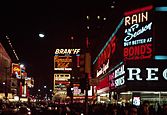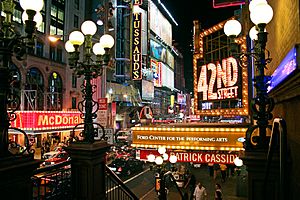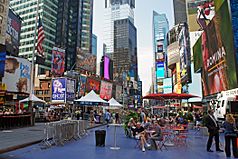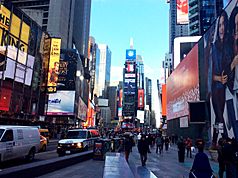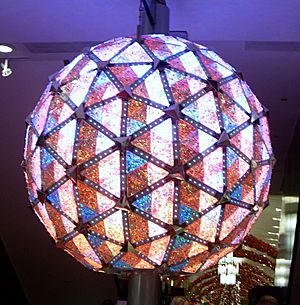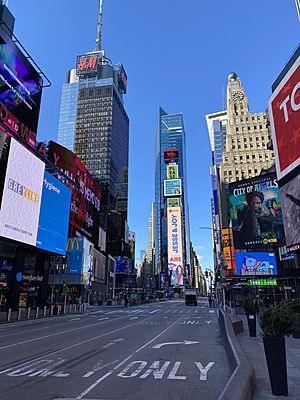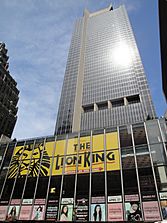Times Square facts for kids
Quick facts for kids
Times Square
|
||
|---|---|---|
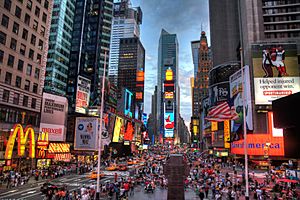 |
||
|
||
| Country | ||
| State | ||
| City | New York City | |
| County | New York | |
| Community district | Manhattan 5 | |
| Boundaries | Broadway, 7th Avenue, 42nd and 47th Streets | |
| Subway services | ||
| Bus routes | M7, M20, M42, M50, M104 | |
| Historical features | Duffy Square George Michael Cohan statue One Times Square |
|
Times Square is a super famous spot in Manhattan, New York City. It's where Broadway and Seventh Avenue cross 42nd Street. Think of it as a giant, bright bowtie-shaped plaza, stretching five blocks between 42nd and 47th Streets.
This area is always glowing with huge digital billboards and ads. It's one of the busiest places for people walking in the world. Times Square is also the heart of the Broadway Theater District and a major center for the world's entertainment industry. It's one of the most visited tourist spots, attracting about 50 million visitors every year. On its busiest days, over 460,000 people walk through Times Square. The subway stations here are also among the busiest in the New York City Subway system.
Times Square used to be called Longacre Square. It got its new name in 1904 when The New York Times newspaper moved its main office to the new Times Building, which is now called One Times Square. Every year on New Year's Eve, a special ball drop happens here. This tradition started on December 31, 1907, and still brings over a million people to Times Square, plus a billion more watching online or on TV.
Times Square is also the starting point of the Lincoln Highway. This was the first road that went all the way across the United States for cars. People sometimes call Times Square "the Crossroads of the World" or "the heart of the Great White Way" because it's so famous and lively.
Contents
What Times Square Looks Like
Times Square acts like a big town square, but it's not actually square-shaped. It looks more like a bowtie. This shape happens because Broadway cuts diagonally through the usual straight-line streets of Manhattan. The "bowtie" has two triangle-shaped areas.
The southern triangle, below 45th Street, is officially called Times Square. The northern triangle is known as Duffy Square. This area was named in 1939 to honor Father Francis P. Duffy, a chaplain from World War I. You can find a statue of him there, along with a statue of the famous entertainer George M. Cohan. There's also the TKTS booth, where you can buy discounted tickets for Broadway shows on the same day.
A Look Back: History of Times Square
How Times Square Began
Long, long ago, when Dutch settlers first came to Manhattan Island, three small streams met near what is now 10th Avenue and 40th Street. These streams formed a larger one called the "Great Kill." This stream flowed through a marshy area known for fish and birds, eventually emptying into the Hudson River at 42nd Street. A small village called Great Kill grew there, known for making horse carriages.
Later, this land belonged to John Morin Scott, a general who served with George Washington. His large house was around 43rd Street, surrounded by farms and horse-breeding areas. In the early 1800s, a very rich man named John Jacob Astor bought the land. He made a lot of money selling pieces of it for hotels and other buildings as New York City grew northward.
By 1872, the area was the center of New York's horse carriage business. The city didn't have a name for it yet, so they called it Longacre Square. This name came from a similar area in London, England, where horse and carriage businesses were located.
As more businesses and factories moved north from downtown Manhattan, Longacre Square became known as the Thieves Lair. The first theater in the square, the Olympia, was built by Oscar Hammerstein I, a cigar maker. By the 1890s, this once quiet area was filled with electric lights and crowds going to theaters, restaurants, and cafes.
The 1900s: Renaming and Growth
In 1904, Adolph S. Ochs, the publisher of New York Times, moved his newspaper to a new skyscraper at 42nd Street in Longacre Square. Ochs convinced the mayor to build a subway station there. Because of this, the area was renamed "Times Square" on April 8, 1904. Just a few weeks later, the first electric advertisement lit up a bank building nearby.
The New York Times later moved to bigger offices in 1913. The old Times Building, now called One Times Square, is famous for the New Year's Eve ball drop from its roof.
In 1913, the Lincoln Highway Association chose Times Square as the eastern end of the Lincoln Highway. This was the very first road to cross the United States, stretching over 3,389 miles (5,454 km) through 13 states to San Francisco.
Times Square became even more popular after World War I. It turned into a lively cultural center with many theaters, music halls, and fancy hotels. It was a place where people gathered to hear important news and celebrate big events, like sports victories or elections.
Advertising also grew a lot in the 1920s. For example, a huge chewing gum sign cost $9,000 a month to rent! Famous entertainers like Irving Berlin, Charlie Chaplin, and Fred Astaire were often seen around Times Square during this time.
Mid-20th Century: Changes and Celebrations
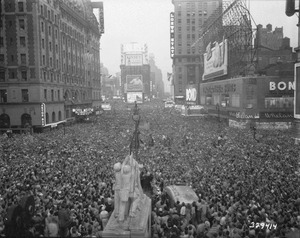
When the Great Depression started in the 1930s, the feel of Times Square changed. Many people moved to cheaper neighborhoods, and some popular theaters closed. The area gained a reputation for being a bit rough in the following years.
However, Times Square still hosted the annual ball drop on New Year's Eve. During World War II, the ball drop was paused in 1942 and 1943. Instead, people observed a moment of silence at midnight, with church bells playing from sound trucks.
On May 8, 1945, a huge crowd celebrated Victory in Europe Day in Times Square. Then, on August 15, 1945, the biggest crowd ever gathered in Times Square to celebrate Victory over Japan Day, with an estimated two million people. The news was announced on the "zipper" news ticker at One Times Square.
Late 20th Century: Rebuilding and Renewal
By the 1960s, parts of Times Square were described as run-down. Conditions became worse in the 1970s and 1980s. In the mid-1980s, the area had many crime reports each year.
In the 1980s, a plan to rebuild and improve the area began. New office buildings and hotels were constructed. In 1987, the city made a rule that new buildings in Times Square had to include large, bright signs. This was to make sure the area stayed lit up at night.
Many new buildings were finished around the early 1990s. At first, some of these buildings were empty. But then, big companies like Bertelsmann and Morgan Stanley bought buildings there, helping Times Square to start looking better.
Making Times Square Shine Again
In the 1990s, Mayor Rudolph Giuliani led a big effort to clean up Times Square. Security was increased, and older, less popular businesses were encouraged to move. More tourist-friendly attractions and nicer shops and restaurants opened.
People who supported these changes said the area became much safer and cleaner. Some critics felt that Times Square lost some of its unique character and became too "Disney-like." However, the changes were greatly helped by The Walt Disney Company, which bought and restored the New Amsterdam Theatre. This encouraged other big attractions like Madame Tussauds Wax Museum and AMC Theatres to move to 42nd Street. This led to even more new office towers, hotels, and tourist spots.
Today, Times Square has many exciting attractions. These include ABC's Times Square Studios, where Good Morning America is filmed live. You can also find competing Hershey's and M&M's stores, and many movie theaters. There are also restaurants like Bubba Gump Shrimp Company and Planet Hollywood. More police presence has also made the area safer.
The bright lights and animated signs of Broadway's theaters are a famous symbol of New York. Since 1987, city rules have required building owners to display illuminated signs. Times Square is the only area in New York City with this rule, meaning it has a minimum amount of light required, not a maximum. The number of bright signs here is similar to Las Vegas. These signs are called "spectaculars," and the biggest ones are called "jumbotrons."
Some famous signs include the Toshiba billboard under the New Year's Eve ball, the curved NASDAQ sign, and the curved Coca-Cola sign. Times Square even got its first environmentally friendly billboard in 2008, powered by wind and solar energy.
Times Square Today: 2000s to Now
In 2002, New York City's new mayor, Michael Bloomberg, took his oath of office in Times Square as part of the New Year's celebration. About 500,000 people were there. Security was very tight after the September 11 attacks in 2001.
Times Square also started hosting other big yearly events. Since 2002, a huge yoga event called "Mind over Madness" takes place on the summer solstice, with up to 15,000 people. It's a chance to find calm in the busy city. Since 2009, there's also an annual competition to design a special Valentine's Day heart for Times Square.
In 2011, Times Square became a smoke-free zone. New York City made it illegal to smoke in the area, with a $50 fine for those caught. In 2014, a "Super Bowl Boulevard" was held on Broadway, especially in Times Square, for the Super Bowl XLVIII. It had activities like autographs, a giant toboggan run, and photos with the Vince Lombardi Trophy.
Making it a Pedestrian Plaza
In 2009, Mayor Michael Bloomberg announced a big change: traffic lanes on Broadway from 42nd to 47th Street would be closed to cars. These areas would become pedestrian plazas as a test. The goal was to make New York more livable by reducing pollution and making it safer for people walking.
At first, some local businesses worried that closing the street to cars would hurt their sales. The first seats for people were simple plastic lawn chairs, which many New Yorkers found funny. These were later replaced with stronger metal furniture. Even though the plaza had mixed effects on traffic, there were fewer accidents involving cars and people, and more people were walking in Times Square. In 2010, the mayor announced that the pedestrian plazas would become permanent.
The city started rebuilding the plaza in 2010, using special granite stones and benches. The project was fully finished just before New Year's Eve 2016. Safety poles were also installed to protect people on the sidewalks.
Times Square's pedestrian plaza is often visited by people dressed as cartoon characters. They usually ask for tips. In 2015, there were many complaints about these characters. While asking for tips isn't illegal, some people felt it made the area less pleasant. In 2016, the city created "pedestrian flow zones" where people couldn't just stand around, and "activity zones" where costumed characters were allowed to perform.
How Many People Visit Times Square?
Times Square is one of the most visited places in the world. About 360,000 people walk through it every day, which adds up to over 131 million a year. It gets more visitors than all the Disney theme parks worldwide combined! Even if you only count tourists, Times Square is the world's second most visited tourist attraction, right after the Las Vegas Strip.
All these visitors mean big business. About $4.8 billion is spent each year on shopping, entertainment, and hotels in Times Square. For every dollar visitors spend in New York City, 22 cents are spent right here in Times Square.
New Year's Eve Celebrations
Times Square is famous for its annual New Year's Eve ball drop. Around one million people gather in Times Square for the New Year's Eve party. For the year 2000 celebration, reports said about two million people filled Times Square, making it the largest gathering there since the end of World War II in 1945.
The first New Year's Eve ball was dropped in Times Square on December 31, 1907. Since then, it has been the main New Year's celebration in New York City. Hundreds of thousands of people gather to watch the Waterford Crystal ball slowly drop from the top of a building, marking the start of the new year. This tradition replaced fireworks, which were stopped because of fire danger.
During World War II, the ball drop was replaced by a moment of silence and church bells due to wartime rules. Today, a new, energy-efficient LED ball is used, and it's a permanent attraction, used for other celebrations like Valentine's Day and Halloween too.
Thousands of police officers usually watch over the New Year's Eve celebrations. Barriers are set up to manage the huge crowds. The celebrations create a lot of waste, including 3,000 pounds of biodegradable confetti dropped at midnight. City workers and the Times Square Alliance clean up tons of trash after the event.
Times Square During COVID-19
The COVID-19 pandemic in New York City in 2020 greatly reduced the number of people visiting Times Square. Daily visitors dropped from 380,000 to about 108,000 in late 2020. Many hotels, stores, and restaurants in the area had to close. For New Year's Day 2021, Times Square was closed to the public, and observers were spread out in special small areas.
Famous Spots in Times Square
Times Square is a vibrant mix of art and business, with countless bright electric, neon, and LED signs all competing for your attention. Here are some notable examples:
- Coca-Cola sign
- Disney Store Times Square
- Hard Rock Cafe New York
- M&M's World
- Hershey's Chocolate World
- Planet Hollywood
- Times Square Studios – where shows like Good Morning America are broadcast live.
- TKTS – a popular booth for discounted theater tickets, with a cool red triangular staircase where people sit.
- Times Square – a unique sound art piece by Max Neuhaus between 45th and 46th Streets.
|
Major Buildings in the Area
|
"Numbered" Times Square Buildings
Hotels in Times Square
|
Companies with Offices Here Many big companies have offices in Times Square, including:
|
Artists often perform or display their work in Times Square, adding to its vibrant atmosphere.
See also
 In Spanish: Times Square para niños
In Spanish: Times Square para niños
- Duffy Square, the northern part of Times Square
- Good Riddance Day, a fun unofficial holiday celebrated here
- Theater District, Manhattan, the area where Broadway shows are performed
- Lincoln Highway, the historic road that started in Times Square
- Tourism in New York City, for more about visiting NYC


